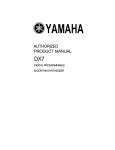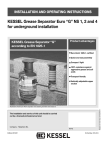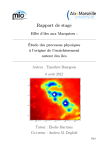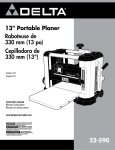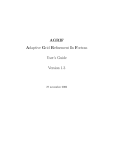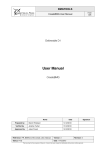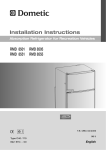Download NEMO/AGRIF Nesting tools User's Guide - Forge
Transcript
NEMO/AGRIF Nesting tools
User’s Guide
January 30, 2006
minor update Dec 6, 2010
1
Contents
1 Introduction
4
2 Installation
6
3 Input file
8
4 Running
16
5 Technical aspects
5.1 Coordinates interpolation . . . . . . . . . . . . . . . .
5.2 Bathymetry building . . . . . . . . . . . . . . . . . . .
5.2.1 Interpolation method . . . . . . . . . . . . . . .
5.2.2 Connection with parent grid bathymetry . . . .
5.2.3 Smoothing method . . . . . . . . . . . . . . . .
5.2.4 Linear connection method . . . . . . . . . . . .
5.2.5 Adding an external high resolution database . .
5.3 Forcing files creation . . . . . . . . . . . . . . . . . . .
5.3.1 Remapping method . . . . . . . . . . . . . . . .
5.3.2 Conservation at the boundaries . . . . . . . . .
5.3.3 Extrapolation process . . . . . . . . . . . . . . .
5.4 Summary of Nesting tools possibilities . . . . . . . . .
5.4.1 What kind of external database for bathymetry
5.4.2 What kind of tracers, flux and momentum fields
5.4.3 What kind of input files are supported . . . . .
2
.
.
.
.
.
.
.
.
.
.
.
.
.
.
.
.
.
.
.
.
.
.
.
.
.
.
.
.
.
.
.
.
.
.
.
.
.
.
.
.
.
.
.
.
.
.
.
.
.
.
.
.
.
.
.
.
.
.
.
.
.
.
.
.
.
.
.
.
.
.
.
.
.
.
.
.
.
.
.
.
.
.
.
.
.
.
.
.
.
.
.
.
.
.
.
.
.
.
.
.
.
.
.
.
.
.
.
.
.
.
.
.
.
.
.
.
.
.
.
.
.
.
.
.
.
.
.
.
.
.
.
.
.
.
.
.
.
.
.
.
.
.
.
.
.
.
.
.
.
.
.
.
.
.
.
.
.
.
.
.
.
.
.
.
.
.
.
.
.
.
.
.
.
.
.
.
.
.
.
.
.
.
.
.
.
.
.
.
.
.
.
.
.
.
.
.
.
.
.
.
.
.
.
.
.
.
.
.
.
.
18
18
18
19
20
20
22
24
24
24
25
25
27
27
27
28
3
Chapter 1
Introduction
This guide presents a series of Fortran 95 procedures that could be useful for the pre-processing
of OPA/NEMO 1 ocean model when running an embbeded model.
The version 9 (called ”NEMO”) of the code makes use of the AGRIF2 grid refinement
procedure developed at the LMC-IMAG. AGRIF is a Fortran 95 package for the inclusion of
adaptive mesh refinement (AMR) features within a finite difference numerical model.
To implement an embbeded model using AGRIF, the user needs to provide a whole set of
data containing the surface forcing fields and the initial conditions for each child domain of the
grid hierarchy. Indeed for a NEMO/AGRIF run each grid must have his own input files namely
bathymetry, coordinates and forcing fields files.
This package provides procedures that have been designed to perform these tasks, including
bathymetry interpolation and smoothing as well as forcing data interpolation.
The next chapter describes system requirements and installation process, while the following
sections describe how to use nesting tools and the various capabilities provided.
1
2
http://www.lodyc.jussieu.fr/NEMO/
http://www-lmc.imag.fr/IDOPT/AGRIF/
4
5
Chapter 2
Installation
The distribution file is a gzipped tarfile, so you must uncompress the file using ”gunzip” and
then extract package from the tar file using ”tar -xvf nesting tools.tar”. The extraction process
will create a directory called Nesting tools
System requirement
In order to compile nesting tools, you need a Fortran 95 compiler and a netCDF library
(http://my.unidata.ucar.edu/content/software/netcdf/index.html) with F90 enabled.
This toolbox has been tested on Linux workstations with g95, pgf90 (version 5.2-4 or later)
and ifort9.0 compilers, as well as on Alpha platform with f95 compiler. In the src/ directory,
you must edit the makefile corresponding to your compiler in order to insert the appropriate
path to netCDF library.
Once the makefile has been properly edited, type “make” and let it work. By default, the
makefile builds in bin/ directory four executables named :
• create coordinates.exe : computation of child grid coordinates
• create bathy.exe : bathymetry interpolation, smoothing and connection
• create data.exe : interpolation of the parent surface fluxes and tracers on child grid
• create restart.exe : interpolation of a parent restart file on a given child grid
6
7
Chapter 3
Input file
The different options of the Nesting Tools are passed to the program through an entry file
which has the structure of a namelist file.
Namelist Input
The namelist input file name can be given as an argument to various executables. By default
this file is called ’namelist.input’ and contains a group of namelist described in Fig. 3.1.
8
Figure 3.1: Required input namelist.
&coarse_grid_files
parent_coordinate_file = ’coordinates.nc’
parent_bathy_level
= ’bathy_level.nc’
parent_meshmask_file = 'meshmask.nc' ! must contain mbathy
/
&bathymetry
new_topo = true
elevation_database = ’etopo2.nc’
elevation_name
= 'topo'
smoothing = true
smoothing_factor = 0.6
nb_connection_pts = 3
removeclosedseas = true
type_bathy_interp = 1
/
&nesting
imin = 56
! i-direction lower left point indice
imax = 76
! i-direction upper right point indice
jmin = 30
! j-direction lower left point indice
jmax = 50
! j-direction upper right point indice
rho = 3
! space refinement ratio
rhot = 3
! time refinement ratio (only for restart)
/
&vertical_grid
!
! Vertical grid parameter for domzgr ( see par_ORCA.h90 or par_NATL.h90 files )
!
ppkth = 21.4333619793800
ppacr = 3
ppdzmin = 0
pphmax = 0
psur = -4762.96143546300
pa0 = 255.58049070440
pa1 = 245.58132232490
N = 31
/
9
&partial_cells
partial_steps = true
parent_bathy_meter = ’bathy_meter.nc’
parent_batmet_name
= 'Bathymetry'
e3zps_min = 50.
e3zps_rat = 0.25
/
&nemo_coarse_grid
jpizoom = 1
! left bottom (i,j) indices of the zoom
jpjzoom = 1
! in data domain indices
/
&wind_stress
taux_file = ’taux_1m.nc’
tauy_file = ’tauy_1m.nc’
/
&forcing_files
FLX_FILES =
’data_1m_salinity_nomask.nc’,
’data_1m_potential_temperature_nomask.nc’,
’flx.nc’,
’geothermal_heating.nc’
/
&interp
VAR_INTERP =
’votemper/bilinear/conservative’,
’vosaline/bilinear/conservative’,
’heatflow/bilinear/conservative’
/
&restart
restart_file = ’/NULL’
shlat = 0
dimg = false
dimg_output_file = ’test_dimg’
adatrj = 360,25
interp_type = ’bilinear
/
10
Namelist coarse grid files
number of ocean levels (T points in the ocean)
The first part of this namelist contains path to files needed for bathymetry and coordinates
parent_meshmask_file
interpolation process. parent bathy level and parent coordinate f ile are names of parent grid
bathymetry file in levels and parent grid coordinates file.
meshmask file containing the mbathy variable
Namelist bathymetry
The bathymetry on the child grid can either be interpolated from parent grid values (if flag
new topo is set to false) or be recomputed from an external database (etopo2 or OPA format
file currently) in that case elevation database should contain the path to this fine bathymetry
called elevation_name
file. To avoid too important bathymetry gradients a smoothing algorithm is available ( if flag
smoothing is set to true ) and is carried out according to a criteria called smoothing f actor
whose values are typically between 0.6 and 0.8. Actually, smoothing f actor is slope parameter
(factor = grad(h)/h)) maximum value for topography smoothing.
One can choose to avoid applying smoothing (in the case of tuned bathymetry) then smoothing must be false. In order to ensure the compatibility between parent grid and fine grid
bathymetry, a linear connection is made on the boundaries of fine domain on nb connection pts
points.
Thanks to removeclosedseas parameter it is possible to remove closed seas from your fine
grid domain. This option can be useful when using for example etopo2 database which can add
some extra seas in fine domain. Figure 3.2 illustrates this problem with a zoom on the gulf of
Mexico from NATL3, we see that when using etopo2 a part of Pacific Ocean is incorporated
whereas large scale domain doesn’t contain it.
If a high resolution bathymetry is provided as input, one can choose between median average (type bathy interp = 1), arithmetic average (type bathy interp = 0) interpolation methods
as well as bilinear interpolation (type bathy interp = 2). Without any external bathymetry
dataset, a bilinear interpolation is carried out. When user aims at using mesh refinement in two
way grid nesting mode it’s possible to update parent domain bathymetry in order to ensure the
compatibility between coarse and fine grids masks for interior points of the nest. This action
is carried out when parent bathy update variable is true, then one can choose the name of the
updated parent bathymetry file thanks to updated parent f ile variable.
11
removeclosedseas = true
removeclosedseas = false
Figure 3.2: Example of the influence of removeclosedseas option in a zoom on the gulf of Mexico
from NATL3 configuration.
12
Namelist nesting
The third section is very important to implement an embbeded model. Here is the specification
of fine grid position on its parent grid and its space and time refinement factor.
imin,imax,jmin and jmax refer to the positions of the fine grid corners, relatively to its parent
starting with the value 1 in each space direction. When the user writes these positions, one has
to take care that fine grid is contained in the parent grid. (imin,jmin) are the lower left corner
coordinates and (imax,jmax) are the upper right corner position.
Those values must be identical to the ones given in the ”Agrif FixedGrid.in” when running the
model. rho and rhot are space and time refinement ratio (time refinement ratio is used only
when creating a restart file).
Namelist vertical grid
Vertical grid section contains various parameters related to vertical grid structure in z-coordinates.
N refers to the number of vertical levels and ppacr is the stretching factor for the grid while
ppkth is the approximate layer number above which stretching will be maximum. Values of
those variables can be found in NEMO source code ( for example in file par ORCA R2.h90
for ORCA2 LIM configuration ), note that as AGRIF doesn’t yet support vertical refinement,
the number N of vertical levels must be the same for each grid of the hierarchy.
ppdzmin is the vertical thickness of the top layer in meters and pphmax is the maximum depth
of the ocean. If in NEMO .h90 file ppdzmin and pphmax are initialized with character string
’pp not used’, insteed of those parameters you have to specify pa0,pa1 and psur also defined in
this configuration file.
Namelist partial cells
The NEMO code offers the option to include partial cells at the bottom in order to better
resolve topographic variations. If this option is chosen an additional bathymetry file in meters
is required by NEMO. In this case partial steps must be set to true and you have to add the
path to parent bathymetry file in meters.
e3zps min is the minimun thickness of the partial step and e3zps rat is the minimun percentage
of the partial step regarding to corresponding level thickness. Those both parameters should
stay the same than in NEMO namelists .
13
The jpizoom and jpjzoom variables are parent grid lower left position on a large model (eg
ORCA2).
Namelist files
The wind stress and forcing file sections enables the user to specify which parent fluxes files to
interpolate on child grid. Then, in interp section user can choose what type of interpolation
will be used for each variable among ’bilinear’ and ’bicubic’. It’s also possible to choose a
correction of child grid values in order to ensure conservation on cells at the boundaries. When
one doesn’t have any wind stress files to interpolate (in case of coupled run), just set taux file
= ’/NULL’.
Namelist restart
If restart file interpolation is required, restart f ile variable determines the location of the parent file. shlat defines the lateral friction : shlat = 0, free slip (no shear along the coast); shlat
= 2, no slip (specified zero velocity at the coast). The value shlat is used for the computation
of the relative vorticity.
One can choose the format of the output restart file; by default a file in netcdf format is created
but dimg format file can be built when dimg value is true, in this case the name of the output
file is dimg output f ile and user must specify adatrj which corresponds to number of elapsed
days since the begining of the run given by ocean.output file (not needed for netcdf format
file). Then the type of interpolation applied to restart file variables is type interp and one
can choose bicubic or bilinear interpolation. When using dimg format compiler options like
”-assume byterecl and -convert big endian” (used by ifort compiler) can be required.
14
15
Chapter 4
Running
Once namelist input file is propely filled in, it’s possible to run the code. For basic NEMO
run using AGRIF capabilities you have to execute following programs, create coordinates.exe
must be execute first :
1. ./create coordinates.exe namelist file
2. ./create bathy.exe namelist file
3. ./create data.exe namelist file
If your namelist file is called ’namelist.input’, you don’t need to specify namelist file name as
argument. Additional executable named create restart.exe interpolates any given parent grid
restart file on child grid.
If your grid hierarchy comprises n levels you just have to create a namelist file for each level
and fill in data file section with files created at level n-1 in that case you should give value 1
for jpizoom and jpjzoom.
16
17
Chapter 5
Technical aspects
5.1
Coordinates interpolation
This part aims at describing the work carried out by create coordinates.exe. This executable
creates coordinates file for child grid according to his position into coarser grid. The type of
interpolation used for this task is currently 4th order polynomial interpolation. The general
operations are described below. Let (λ,φ,z) be the geographical coordinates system.
1. Interpolation of latitude and longitude coordinates on
child grid at T,U,V and F points
2. Scale factors computation on T,U,V and F points
�
- e1 = (a + z)
( ∂λ
∂i
�
- e2 = (a + z)
( ∂λ
∂j
2
( ∂φ
)2
∂i
2
( ∂φ
)2
∂j
cos φ) +
cos φ) +
�1
2
�1
2
It’s possible to easily change directly in the code if user prefers to apply an interpolation
process for e1 and e2 computation.
5.2
Bathymetry building
This is a crucial part when running an embedded model. Various options are offered for the
creation of child grid bathymetry. As mentioned in chapter 3 users can choose between full steps
18
and partial steps, the code also offers the possibility to use external high resolution database
in order to better resolve topographic variations. This section presents some key components
of bathymetry construction, namely smoothing and interpolation method as well as connection
with parent grid bathymetry.
5.2.1
Interpolation method
Interpolation from parent bathymetry
The method used to interpolate bathymetry on child grid is bilinear interpolation based on
SCRIP1 (Spherical Coordinates Remapping Interpolation Package). The first step is to compute
remapping weights, then interpolation process is similar to a matrix-vector multiplication.
(c1 c2
. . . cn )
w11 w12
w21 w22
..
..
.
.
wn1 wn2
. . . w1m
. . . w2m
..
...
.
. . . wnm
= (f1 f2 . . . fm )
The 1xn matrix C contains the 2D coarse grid field to interpolate unrolled into a single
vector. The 1xm matrix F is the result of matrix multiplication so F contains the interpolated
field on fine grid. Bathymetry is mapped with weights calculated using SCRIP’s bilinear interpolation scheme in a quadrilateral grid. This scheme is quite simple to explain : let’s consider
point P on destination grid, we search for a cell formed by four points on source grid containing
P and then the remapping weights must be assigned to each of those four points.
Interpolation from external high resolution bathymetry
When using a high resolution bathymetry the relevance of bilinear interpolation is not obvious.
In this way an interpolation method based on an average of all high resolution points contained
in a given child grid cell has been implemented. This method is quite simple, the value assigned
to every child grid points is the average of all high resolution points present in its cell. There is
two different way to carry out this average indeed user have the possibility to choose between
arithmetic and median average.
1
http://climate.lanl.gov/Software/SCRIP/
19
5.2.2
Connection with parent grid bathymetry
The bathymetry thus interpolated will be connected to the parent topography before being
smoothed .
The connection is made on three coarse grid cells at the boundaries of child grid as well as
on both ghost cells. This connection is not exactly the same between full cells and partial cells.
Then the way to connect this connection zone to the rest of the interior high resolution domain
is a linear connection.
Full cells
In full cells configuration only bathymetry in levels is required. So the connection is simply made
by copying parent grid values on corresponding child grid cells as shown in figure 5.1. Then
bathymetry in levels is converted into meters in order to implement smoothing process. This
smoothing is carried out by using interior domain points. To ensure connection between interior
domain and boundaries a linear connection is made. The bathymetry is then reconverted in
levels.
Partial cells
In partial cells the process is quite similar. But in this case we work directly on bathymetry
in meters. For the three coarse cells at the boundaries, it’s no need to directly copy parent
value, we just have to take care about the fact that child grid value remain at the same level
than corresponding parent grid value. The interpolation process (1D in each space directions)
is based on Van Leer slope limiters with an additional criterion to check that the interpolated
points remain at the same level.
5.2.3
Smoothing method
In order to prevent horizontal pressure gradients errors, interpolated bathymetry requires some
smoothing. This is not the values of bathymetry but the values of its logarithm that are
smoothed. This is a usual method which ensures that the smoothing won’t be too strong in
deep areas. The logarithm of the bathymetry (whose derivative is dh
) will be smoothed until it
h
fits the slope parameter called smoothing f actor in nesting tools namelist file. Thus the stop
criterion of the smoothing algorithm is when dh
≤ smoothing f actor on all points. The method
h
used to carry out this smoothing makes use of hanning filter, if we note lnh the logarithm of h
hanning filter is defined by :
lnh(i, j) =
1
[lnh(i − 1, j) + lnh(i + 1, j) + lnh(i, j − 1) + lnh(i, j + 1) + 4 ∗ lnh(i, j)]
8
20
Fine grid western boundary
j_coarse = jmin+1
i_coarse = imin+1
Coarse grid points
Ghost points
Connection zone : copy of parent grid values
Points involved in linear connection process
Figure 5.1: Bathymetry connection process for full cells (example with space refinement ratio
=3)
21
Then the following convolution kernel is applied to resulting bathymetry
1
K=
64
0 0
0
0 0
1 −2 1
0 0
5 −9 74 1 0
1 −4 −9 −2 0
0 1
5
1 0
we can note that the sum of the elements of this 5x5 kernel is equal to 1, so this kernel
is normalized. If the kernel has m rows and n columns, mathematically we can write the
convolution as:
lnhsmoothed (i, j) =
m �
n
�
k=1 l=1
lnh(i + k − 1, j + l − 1)K(k, l)
Smoothing algorithm iterates those two steps as long as smoothing criterion isn’t satisfy..
5.2.4
Linear connection method
In this case, fine grid bathymetry and interpolated coarse grid bathymetry fields are blended
across the nb connection pts ( mentioned in namelist.input file ) outer rows and columns of the
fine grid. The blending is a simple linear weighting between the interpolated coarse grid values
and the fine grid values from the input file. The weighting scheme for a 5 point connection is
given as :
• row/column 1 : 100% interpolated coarse grid, 0% fine grid
• row/column 2 : 75% interpolated coarse grid, 25% fine grid
• row/column 3 : 50% interpolated coarse grid, 50% fine grid
• row/column 4 : 25% interpolated coarse grid, 75% fine grid
• row/column 5 : 0% interpolated coarse grid, 100% fine grid
This relaxation zone takes place between the three coarse grid at the boundaries and the
interior domain.
22
netcdf etopo_file {
dimensions:
lon = x ;
lat = y ;
variables:
float lon(lon) ;
float lat(lat) ;
float topo(lat, lon) ;
}
netcdf OPA_format_file {
dimensions:
x = 182 ;
y = 149 ;
variables:
float nav_lon(y, x) ;
float nav_lat(y, x) ;
float Bathymetry(y, x) ;
}
Figure 5.2: sample input high resolution bathymetry file
23
child grid point
coarse grid point
( i ,j+1 )
( i+1 ,j+1 )
P
( i ,j )
( i+1 ,j )
Figure 5.3: Coarse grid points box around a child grid point to interpolate
5.2.5
Adding an external high resolution database
The current code of nesting tools is designed to include etopo2 global elevation data base
gridded at 2-minute (latitude-longitude) resolution as well as various OPA format bathymetry
file. The user can choose to add his own database for bathymetry interpolation. In that way
the code is flexible and is able to properly work if this external database is in netcdf format
with the structure presented in figure 5.2. If for any reasons user doesn’t want to change the
structure of his file to match the structure required by the code, it’s of course possible to edit
directly in the code the routine responsible for external bathymetry file reading.
5.3
Forcing files creation
5.3.1
Remapping method
As introduced in section 5.2.1 we use remapping to interpolate various fields between coarse
domain grid and fine domain grid. Remapping method are well adapted in our case because it
accelerates interpolation process. Indeed remapping matrix is calculated once for all and can
be re-used for all fields and also for all levels if fields to interpolate are not masked. At this
point we have the choice between bilinear and bicubic interpolation schemes. We can quickly
present those both methods. Let f be the function to approximate on child grid point P. A
search algorithm on coarse grid finds in which box the point P resides. If we use indices defined
in figure 5.3, bilinear scheme gives
24
fP = w1 f (i, j) + w2 f (i + 1, j + 1) + w3 f (i + 1, j + 1) + w4 f (i, j + 1)
whereas bicubic scheme can be written
fP = w1 f (i, j) + w2 f (i + 1, j + 1) + w3 f (i + 1, j + 1) + w4 f (i, j + 1)+
w5 ∂f
(i, j) + w6 ∂f
(i + 1, j) + w7 ∂f
(i + 1, j + 1) + w8 ∂f
(i, j + 1)
∂i
∂i
∂i
∂i
w9 ∂f
(i, j) + w10 ∂f
(i + 1, j) + w11 ∂f
(i + 1, j + 1) + w12 ∂f
(i, j + 1)
∂j
∂j
∂j
∂j
2
2
2
2
∂ f
∂ f
∂ f
∂ f
w13 ∂i∂j
(i, j) + w14 ∂i∂j
(i + 1, j) + w15 ∂i∂j
(i + 1, j + 1) + w16 ∂i∂j
(i, j + 1)
For each field to interpolate user can choose between the both schemes. You can note that
bicubic remapping can create some local extrema whereas values interpolated thanks to bilinear
scheme are limited by parent grid values.
5.3.2
Conservation at the boundaries
For two way interactive grid nesting user can choose to ensure conservation mainly for tracers.
This conservation is implemented on the two coarse grid cells at the boundary of child grid,
namely the zone where coarse grid points will be updated. The process is quite simple a
correction is applied to each fine grid points covered by the same coarse grid cell. If we note α
this correction, ρx and ρy space refinement ratio in x and y direction, for a field F the correction
is given by :
α = ρx .ρy .Fcoarse −
5.3.3
ρy
ρx �
�
Ff ine (i, j)
i=1 j=1
Extrapolation process
This part is useful when the field to interpolate on child grid is already masked ( e.g. when
interpolating restart files fields). Indeed the main drawback of SCRIP package is the fact that it
doesn’t manage extrapolations. During search algorithm if one of the four points surrounding
one given child grid point to interpolate is masked then no interpolation is done and child
grid point receive the value zero even if this point is not masked. So we have to preprocess
25
LEVEL
N+1
LEVEL
N
Figure 5.4: Directions investigated around a point where extrapolation is required.
interpolation step to avoid such problems by correcting mask on coarse grid and giving value to
points where mask has been changed. The principle is to construct a box around the point to
be extrapolated (as shown in figure 5.4) and to search for all no masked points candidates for
this extrapolation. Then between all possible points we calculate the error made by replacing
the value of the point to be extrapolated with this new possible value. Using Taylor expansion,
the error is given by
|f (x + hx , y + hy ) − f (x, y)| = |hx
∂f
∂f
+ hy |
∂x
∂y
So at each no masked points around a point to be extrapolated we compute gradients in x and
y directions as well as distances hx and hy . Of course the point giving minimum error is chosen
for extrapolation.
26
5.4
5.4.1
Summary of Nesting tools possibilities
What kind of external database for bathymetry
The choice of high resolution database for bathymetry is linked to the resolution of child grid.
The use of etopo2 is not completely relevant in case of an ORCA2 zoom, it would be better
to use a higher resolution ORCA bathymetry. For example, for an ORCA2 zoom with a space
refinement ratio of 3 the best choice could consist in using ORCA05 or ORCA025 bathymetry.
If one already owns a tuned fine bathymetry mapped on the fine grid points, the smoothing
option isn’t relevant indeed the smoothing algorithm could modify the values of this improved
bathymetry. If no smoothing option is activated, outside the connection zone the interior domain bathymetry stay the same than the one given by the external file.
The type of interpolation used is closely linked to the type of external bathymetry used. Indeed
median and arithmetic average are relevant when the resolution of external bathymetry is much
higher than the one of fine grid (for example when using etopo2). A bilinear interpolation is
more accurate and fast when resolutions are quite similar.
5.4.2
What kind of tracers, flux and momentum fields
This problem is quite similar to the one of the previous section. One can choose to interpolate
the flux, tracers and momentum fields from parent grid files. The code also offer the possibility
to use ORCA025 or ORCA05 forcing files to interpolate on child grid even if one is implementing ORCA2 zoom.
This is a quite easy stuff to do, just replace in the namelist file the coordinate file by the one
corresponding to the new fields, for example ORCA05 coordinate file, and then user have to
mention ORCA05 forcing files names in FLX FILES and wind stress sections. This is relevant
only when forcing files are not masked and when the vertical level position (for 3D fields) is
exactly the same (this is the case between ORCA05 and ORCA2 configurations) because no
vertical interpolation is currently implemented.
The default version of the code doesn’t carry out extrapolation during forcing files interpolation because NEMO standard files are not masked. If user wants to activate extrapolation
during interpolation process on files mentioned by FLX FILES it’s possible to activate this
option by editing agrif interpolation.f90 file, (in routine Interp Extrap var) the logical variable
Extrapolation must be initialize to true value (this option is not available for wind stress files
interpolation).
27
namelist
variable
name
taux file
variable
position
tauy file
V
FLX FILES
T
U
netcdf
file
dimensions
x,y,time counter,
depthu(o),deptht(o)
x,y,time counter,
depthu(o),deptht(o)
x,y,time counter,
deptht or z
variable
type
variable
name
3D
(x,y,time counter)
3D
(x,y,time counter)
4D or 3D
(x,y,time counter)
(x,y,z,time counter)
(x,y,deptht,time counter)
’taux’ or ’sozotaux’
’tauy’ or ’sometauy’
interpolate any name
different from ’nav lat’,
’nav lon’,’nav lev’,
’deptht’,’time steps’,
’time counter’,’tmask’
(o) : optional dimensions
Figure 5.5: Netcdf files structure supported by nesting tools
5.4.3
What kind of input files are supported
The current version of Nesting tools have been fully tested with NATL3 and ORCA2 LIM
configurations (tests with NATL4 and ORCA025 are currently carried out). In the case of
tuned input files, user can refer to figure 5.5 to check the current kind of netcdf file structure
currently supported by nesting tools. Developments are planed to enable the interpolation of
U and V type 4D variables, this feature can be useful when using TOP (ocean tracer and
biochemistry model) or other additional option of NEMO.
28
Bibliography
[1] G. Madec : OPA Ocean General Circulation Model, Reference Manual http
//www.lodyc.jussieu.f r/N EM O
:
[2] Philip W. Jones : A User’s Guide for SCRIP : A Spherical Coordinate Remapping and
Interpolation Package http : //climate.lanl.gov/Sof tware/SCRIP/SCRIP users.pdf
[3] Van Leer B., 1976 : Towards the Ultimate Conservative Difference Scheme. IV. A New
Approach to Numerical Convection, J. Comput. Phys., 23, 276-299
[4] P. Penven and P. Marchesiello : A Regional Oceanic Modeling System with mesh refinement,
pre- and post-processing tools http : //www.brest.ird.f r/Roms tools/
29






























